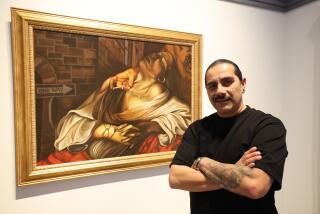Is it a book, puzzle or both?
Paul Di Filippo’s short novel “Cosmocopia” (Payseur & Schmidt: 106 pp., $65) is an art book, in multiple senses of the phrase. There is an artist at its center: Frank Lazorg, whose career describes a trajectory from commercial to fine art, beginning in the 1950s with comics, focusing on “hyper-real yet fantastical book covers for paperback-original novels” during the next two decades (“a gallery of demons and brawny warriors, luscious-bottomed maidens and brawling barbarians, aliens and otherworldly explorers”) and concluding -- or so it seems -- with vivid depictions of “mental landscapes, surreal collages, visions of dimensions beyond.” A stroke has left him physically weak and creatively impotent. “Cosmocopia” is the story of his artistic redemption, a tried-and-true mode, which Di Filippo transforms into a fable at once ludicrous and heartfelt.
“Cosmocopia” is also an art book because it costs 65 clams, comes handsomely bound as a horizontal artifact and shares space in a large box with a 513-piece jigsaw-puzzle of a Jim Woodring illustration inspired by the work (putting the pieces together is tough because everything’s gray). The set also includes a deliciously fiendish full-color scene (also by Woodring) of Lazorg at his demented peak, painting his model blood-red.
You may not know the publisher, Payseur & Schmidt; according to the book’s copyright page, P&S “has embraced the underground for the last 96 years” -- indeed, this is one of the few copyright-page how-do-you-dos worth quoting in full, so here’s the rest:
” . . . releasing over 417 volumes and bearing witness to two World Wars, 17 presidents, 23 resident art directors, five generations, three bankruptcy filings, and one 1906 Pearl Improved #11 letterpress, with offices on 47 planets in 13 solar systems, as well as Cauheegan, Wisconsin, and Seattle, Washington. Like Toxoplasma gondii, we remain.”
What is “Cosmocopia,” then? Just the book? All these goodies, I mean items, together?
The high-end presentation of “Cosmocopia” is itself a commentary on the story, and Di Filippo and Woodring’s (and Payseur & Schmidt’s) multiform production is more than just so many bells and whistles.
The above précis of Lazorg’s artistic career shows his steady movement from low to high art (quotation marks should go around both “low” and “high”), a restlessness that can be read as a series of rejections of lubricious, juvenile fare. In a plot development straight out of a pulp story, the spent artist receives a mysterious package, partakes of the occult-rejuvenating powder therein and winds up with a horrifying murder on his hands. In the throes of his climactic masterpiece, he is translated into a completely alien world -- that is, he’s a character in the sort of story he once provided eye-grabbing, crowd-pleasing visuals for.
The style reads like a loving pastiche of creaky distant-planet narratives. Our first immersion into this new setting (upon being jerked out of Lazorg’s, and ostensibly our, world) begins: “Crutchsump knew that a trove of valuable fresh bones awaited her on the Shulgin Mudflats at the edge of Sidetrack City, where the metropolis met the water of the Rodinian Sea.” The awful, slightly disgusting-sounding name (Crutchsump); the inscrutable folkways (bones? of what? and why would you want them waiting for you?); the meaningless geography (ah, the Rodinian Sea!): Di Filippo slings this deadly stuff so effortlessly that one can be forgiven for releasing an inward groan.
But soon he’s unloading a “Jabberwocky”-size helping of impenetrable neologisms -- shifflets, grapple-gnaws, mockmucks, gorgit vendors, trindlebrumes and much more -- and deploying antique vocabularies, and the effect is comic, disorienting and evocative, sometimes all at once. A creature is turned into “a heap of calcific flinders”; “juncos, lammergeiers and questrals . . . parceled the sky into avian empires.”
All books are worlds created out of language, and “Cosmocopia” presses this to the breaking point. Even as Di Filippo elides the issue of translation (Crutchsump immediately understands what this oddly shaped visitor is saying), he plays with the idea that certain concepts simply have no equivalent. A reenergized Lazorg spends the majority of the novel in Crutchsump’s world, which has no signs, no writing and, alas, nothing resembling his preferred mode of creative expression. (“What is ‘painting’?” Crutchsump queries, when Lazorg tells it about his previous profession. “Is it a kind of thing like ‘writing’?”)
There is no art, per se, on this world, but something called “ideation” exists -- a sort of standardized sculpture involving mental strength and something called nacre. Di Filippo nimbly describes the process (or “technics”), giving plenty of details while preserving the form’s essential strangeness. Even more fun is his take on alien sex. Crutchsump explains to Lazorg: “Male and female are variable roles based on size. During mating, whichever introciptor is the smaller will slip inside whichever is the larger. The smaller is considered the male.” (Introciptor?) Lazorg and Crutchsump may be anatomically incompatible denizens of parallel universes, but one absurdly roots for them to hook up.
“Cosmocopia” fluctuates between a jeu d’esprit and a portrait of the artist as an old man. Di Filippo has implanted a bizarre, funny and melodramatically inclined fantasy world within the “real” world of his story. This is the author’s way of showing both the nightmarish multiplicity of worlds and the hazy line demarcating genre art from a supposedly higher form.
Ed Park is the author the novel “Personal Days.” His Astral Weeks column appears monthly at www.latimes.com/books.
More to Read
The biggest entertainment stories
Get our big stories about Hollywood, film, television, music, arts, culture and more right in your inbox as soon as they publish.
You may occasionally receive promotional content from the Los Angeles Times.






